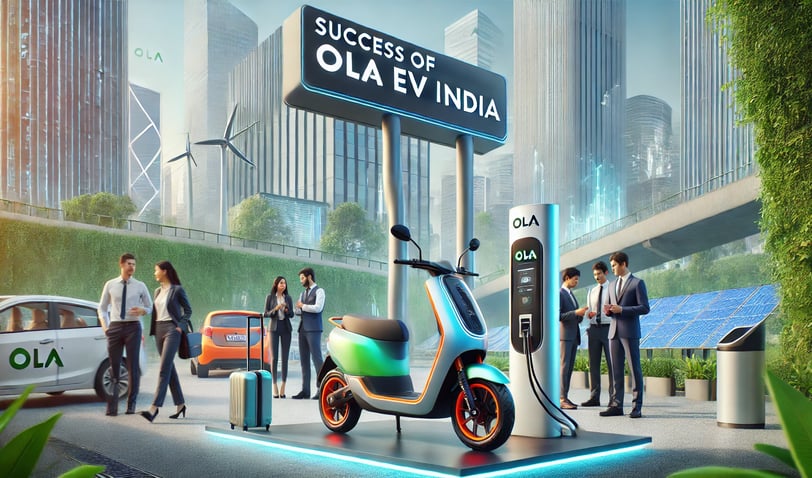The Success of Ola EV in India
Last year, while waiting for my Ola ride in a crowded part of Delhi, something surprising happened. A sleek electric scooter pulled up instead of the usual petrol bike. The driver—friendly, as most Ola drivers are—told me it was an Ola Electric scooter. Curious, I asked a few questions and learned he had switched because it was cheaper, quieter, and frankly, more futuristic. That ride wasn’t just another trip home; it was a revelation about how electric vehicles (EVs) could reshape transportation in India. Since then, I’ve been fascinated by the success of Ola EV in India and why it matters to students, professionals, and the environment alike.
Laksh Rathore
12/3/20243 min read


The Success of Ola EV in India
Introduction: Why Ola EV Got Me Thinking
Last year, while waiting for my Ola ride in a crowded part of Delhi, something surprising happened. A sleek electric scooter pulled up instead of the usual petrol bike. The driver—friendly, as most Ola drivers are—told me it was an Ola Electric scooter. Curious, I asked a few questions and learned he had switched because it was cheaper, quieter, and frankly, more futuristic. That ride wasn’t just another trip home; it was a revelation about how electric vehicles (EVs) could reshape transportation in India. Since then, I’ve been fascinated by the success of Ola EV in India and why it matters to students, professionals, and the environment alike.
1. A Shift Towards Sustainability
Growing up, I often saw smoky exhausts and jam-packed petrol pumps as part of daily life. Cars and scooters fueled by petrol or diesel felt like the default choice. But now, I see more and more people switching to EVs, and Ola Electric is at the forefront of this change. What’s driving this shift?
In my opinion, one major factor is growing environmental awareness. People—especially younger generations like mine—are more conscious of climate change. We know the stats: transportation accounts for nearly 14% of global greenhouse gas emissions, and India’s urban pollution crisis is no secret. Ola’s EV lineup offers a cleaner alternative that aligns with this collective responsibility to protect our planet.
Interestingly, according to a report by BloombergNEF, EV sales in India are expected to account for 30% of all new vehicle sales by 2030. Ola’s aggressive marketing and competitive pricing have helped it become a household name in this emerging sector. What I’ve learned is that these changes aren’t just about big policy shifts—they’re also about individual decisions to embrace sustainable options.
2. Affordability and Accessibility
When it comes to affordability, Ola EV hits the sweet spot for many Indians. Let’s face it: as students, we’re always on a budget. Whether it’s splitting a cab fare with friends or choosing the cheapest way to get to college, every rupee counts. Ola’s electric scooters and ride services save money in the long run by cutting fuel costs and maintenance expenses.
Take the Ola S1, for instance. Priced competitively, it offers impressive mileage for an electric scooter and requires far less maintenance than its petrol counterparts. An article I read on Economic Times mentioned that the running cost of an electric scooter is as low as Rs. 0.25 per kilometer compared to Rs. 2-3 per kilometer for petrol scooters. Imagine the savings for a college student who needs to commute daily!
In addition, Ola’s expanding charging network makes EVs more accessible. At first, I wondered, “But what if the battery dies in the middle of nowhere?” Thankfully, Ola’s Hypercharger Network aims to install 100,000 charging stations across 400 cities. Knowing there’s a charging station nearby gives users confidence to switch to electric.
3. Tech Appeal: The Cool Factor
Let’s admit it—EVs have a “cool” factor. Ola’s sleek designs, vibrant color options, and high-tech dashboards appeal to young people like me who grew up surrounded by smartphones and gadgets. During a college event last semester, one of my classmates showed up on his Ola S1 Pro, and it became the star of the evening. With features like app connectivity, navigation, and cruise control, these scooters feel like a blend of transportation and tech.
In my opinion, Ola has done a great job of making EVs aspirational. They’re not just vehicles; they’re a lifestyle upgrade. It’s a similar strategy to what Apple does with iPhones—turning a product into a status symbol.
Conclusion: What Ola EV Means to Me
Reflecting on my journey with Ola Electric, I’ve realized it’s not just about vehicles; it’s about the larger story of how India is adapting to a greener, more efficient future. For students like me, it’s inspiring to see technology and sustainability coming together in such a practical way.
So, what’s next? I think it’s up to us to embrace this change. Whether it’s choosing an Ola EV ride, buying an electric scooter, or simply encouraging family and friends to make the switch, every small step matters. If a company like Ola can spark such a big transformation in just a few years, imagine what we can do as individuals to contribute to a cleaner, smarter India.
